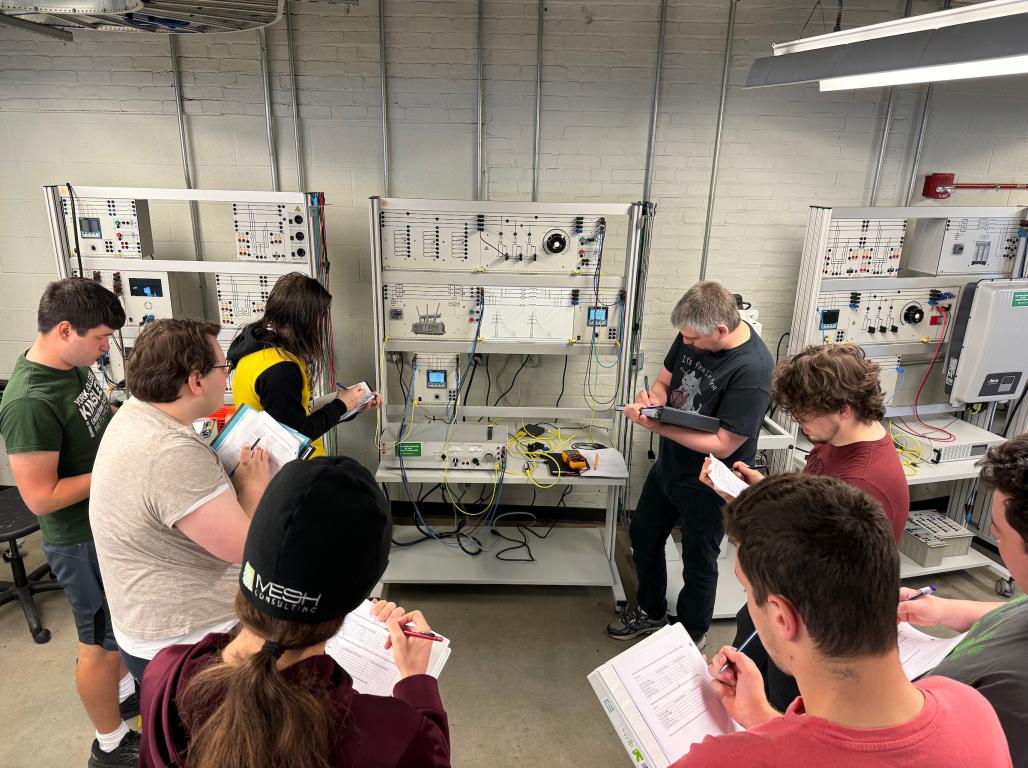New Innovation Classrooms Designed for Active Learning

Over the past year, the Center for Community Engagement (CCE) has worked with various Honors organizations, including the Student Academic Innovation Lab (SAIL), to collect data from students and faculty that could inform a new approach to structuring classrooms at York College.
SAIL used design thinking, a human-centered approach to problem-solving, to gather data from the YCP community. The group organized empathy interviews in which students asked faculty questions they do not traditionally get to ask of their teachers: questions about their frustrations, about what gets in the way of them teaching the way they want, and about how their approach to teaching has changed over the years.
With the data, and with funding from The Graham Fellows Program and The Graham Center for Collaborative Innovation, a new prototype called the Graham Collaborative Innovation Classroom was developed. The classrooms have been designed in order to facilitate active learning.
“Active learning means that both sides of the learning experience are fully engaged in the [learning] process,” says Dr. Dominic DelliCarpini, Dean of the Center for Community Engagement. It’s an approach that puts a greater degree of responsibility on the learner that more passive, traditional methods of instruction, like lecturing, do.
“Everyone engaged in the process has something to contribute,” says Dr. DelliCarpini. “Classrooms often don’t reflect that in the way they’re designed. The generic classrooms have always been based on a very old model of learning–and when I say ‘old’ I mean medieval–that there is someone really smart in the front who’s telling people in the back what’s going on,” he says. “When you restructure the space, you restructure the learning process.”
Two Graham Collaborative Innovation Classrooms are currently being used; Rooms 126 and 144 in the Humanities Center, and that restructuring is evident in every detail. The floor is different. The beige tile is gone, replaced by cool-blue, checkered carpet. Three of the four walls are covered in chalkboard paint, the other, a whiteboard. Nonwriting surfaces are painted white. The lighting is different too, closer to blue-white than yellow, and the bulbs are on a dimmer. The tables are on wheels and easy to push together, and there are separate areas for students to sit in groups, facing each other.
Dr. DelliCarpini says the changes are, first and foremost, meant to encourage students to work together. “It’s important to not have to bounce everything off of the professor,” he says. “It makes students responsible for having a conversation. In my ideal class, I can leave and [the class] would still go on without me.”
Those behind the new classrooms–DelliCarpini prefers learning spaces–are hoping the rooms will serve as a blank slate for professors to explore different pedagogical approaches. “If we have a learning space that has the ability to be altered any given day, we assume professors will come up with unique ways of teaching,” he says.
Dr. Dennis Weiss, a Professor of Philosophy at the College, is currently instructing a first-year seminar called Questioning Technology in HUM144. His classroom can seem uncharacteristically noisy by college standards, even when visited on a Monday morning. Weiss sets up his classroom so that students’ tables are pushed together to form six or seven groups, and each group is deep in conversation, discussing the assignment in front of them. “They read a very famous essay by Nicholas Carr called ‘Is Google Making Us Stupid?’,” and now they have to represent his position,” says Dr. Weiss. To do so, the students are utilizing large sheets of paper, torn from a large roll in the corner of the classroom. “We are doing a lot more group work,” he says. “[The room] lends itself to that.”
More ideas for facilitating student engagement have been given. HUM144 and HUM126 sit back-to-back, and plans have already been proposed to replace the shared wall with something that is removable, so that two related classes–philosophy and business, for example–could merge to create a more interdisciplinary learning environment.
Dr. DelliCarpini hopes that other departments will take notice this semester, and begin to think about designing their own versions of innovation classrooms that are suited for their specific purposes. For now, the focus is on the two rooms in the Humanities Center. Those involved with collecting data will be interviewing students and faculty alike throughout the semester. “It’s a prototype,” says Dr. DelliCarpini, “and we are going to have to iterate it over and over again.”



